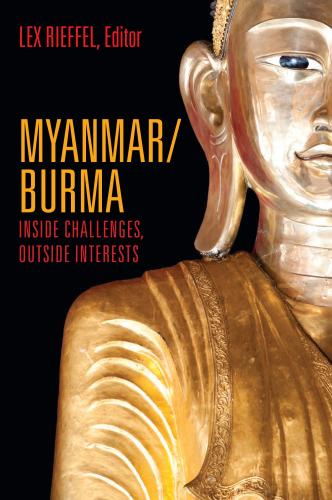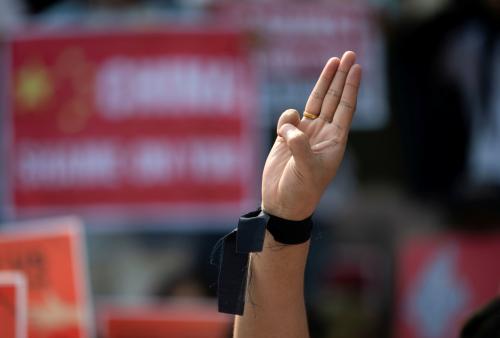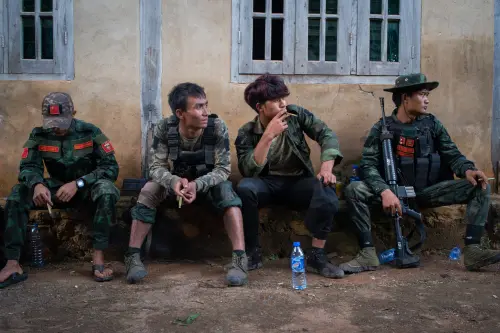This piece is part of a series titled “Nonstate armed actors and illicit economies in 2023” from Brookings’s Initiative on Nonstate Armed Actors.
The second anniversary of the February 2021 coup d’état in Myanmar has just passed, and the abysmal state of armed conflict, insurgency, chaos, and anarchy has only been deteriorating. Despite the repeated calls by regional organizations like the Association of Southeast Asian Nations and by the United Nations to stop the violence, protect human rights, and respect the democratic process, the Burmese military junta has demonstrated no appetite for political concessions or negotiation with the resistance movement. With the uncertainty associated with the postponed general elections this year — which most speculate will be neither free nor fair nor legitimate — the civil war inside Myanmar is likely to only escalate in 2023. There is no end in sight.
Background
Strictly speaking, the civil war in Myanmar has been ongoing since 1948. The fighting between the central government dominated by the Bamar majority and the ethnic armed organizations (EAOs) in seven ethnic states has never completely ceased since the country’s independence decades before the 2021 coup. The country is no stranger to military coups either. The 1962 coup led by General Ne Win replaced the country’s representative democracy with 26 years of military rule. And the landslide victory by Aung San Suu Kyi and her National League for Democracy (NLD) in the 1990 elections was also denied by the military, which held onto power for another 25 years until the NLD won again in the 2015 general elections.
However, the modality of Burmese politics after the 2021 coup has been entirely different. Before the coup, the Burmese people had tasted democracy and freedom and had been exposed to the outside world and the free flow of ideas, information, people, and economic opportunities under a democratic government. They simply refuse to return to more decades of military rule, no matter that the Burmese military sees military rule as its natural prerogative and a normal state for the country. The opposition to the coup and the rejection of military rule have been the most powerful factors uniting the rest of the country and, crucially, driving divergent resistance forces together.
No End in Sight for the Civil War
It is these conditions that have allowed the National Unity Government (NUG) — the shadow civilian government formed by members of the parliament elected during the 2020 general elections — and its armed wing, the People’s Defense Force (PDF), to thrive throughout the country. By 2022, the PDF was estimated to have expanded to more than 250 units with more than 65,000 troops. Even though different militias and units under the PDF framework do not share the same commander or commanding structure, they share the common aspiration of driving the military out of power. At the local level, especially in rural areas where the military junta’s control is weak, the PDF enjoys substantial control of the territory and has been launching attacks against military barracks, police stations, and government administrative offices.
Although the resistance is still fragmented, it somewhat improved in 2022. A sizeable portion of the PDF is either recognized by or under the command of the NUG. Many of the PDF units cooperate or coordinate their positions with the EAOs. The Kachin Independence Army (KIA), the leading ethnic armed organization in the Kachin state, and local PDFs have launched joint attacks against the military in Kachin State and Sagaing Region. The military government’s existence as a shared target and common threat is uniting the NUG, PDF, and EAOs under the same objectives, though not in terms of operations or future post-conflict objectives. Myanmar’s resistance forces still have a long way to go in terms of political negotiation and reconciliation among themselves. However, for the time being, fighting the Burmese military remains the highest priority for all players.
Despite the joint purpose among the resistance forces, it is unfortunate that the Burmese civil war is at a stalemate and will likely remain so for the foreseeable future. The power gap between the Burmese military and the resistance (the PDF and EAOs combined) remains significant, in terms of not only size but also weaponry and firepower. The resistance’s lack of income — which is funded by donations — is particularly striking in comparison to the military’s control over the state and its resources. After all, the Burmese military has the luxury of collecting tax and purchasing weapons from China and Russia, while the PDF and EAOs must rely on underground channels to acquire arms. In terms of territory, some estimate that the PDF and EAOs control 40 to 50% of the country’s territory. Accurate assessment of the control of territory is extremely difficult given the highly volatile battlefield situation and the constant contest for territory between the military and the resistance. And most observers would agree that the territories under PDF control are in less-populated rural and jungle regions, while the Burmese military still firmly holds the population centers, including cities and urban areas. With the continuation of bloody violence during the civil war, the PDF and EAOs are gaining ground in the peripheries of the country, and it is unlikely that the Burmese military can eradicate these groups despite their repeated campaigns against the insurgency. Similarly, despite operations by the PDF and EAOs, a decisive victory to defeat the Burmese military is also improbable in the foreseeable future.
Illegitimate and Destabilizing Elections in 2023?
As stipulated by the 2008 constitution, Myanmar’s state of emergency, which the military declared following the 2021 coup, can only be extended twice. This means that it would end by January 31, 2023, and the country’s general election must be held within six months afterward, i.e., by August 1, 2023. Many people had expected that the military junta would have run out of extensions for the state of emergency, which it believes allowed it to form the State Administrative Council to govern the country. However, by the beginning of February, the military government extended the state of emergency for another six months, citing the “unusual circumstances.” The military’s prior political and legal preparations had indicated that it was planning to hold the election sometime in 2023, but this announcement delays the election by another six months. The military cannot indefinitely postpone it.
Regardless of when the election will be held, it will be highly controversial and destabilizing. As the resistance mobilizes to reject the election, speculation of attacks against polling stations and of efforts to deter people from voting has run rampant. The military junta may see a manipulated election as its ticket to some type of legitimacy. However, the contest for power will only manifest itself through more bloodshed.
International Assistance to the Armed Resistance?
The other potential game changer is international assistance. The 2023 U.S. National Defense Authorization Act has enabled direct engagement with the resistance movement, including providing non-lethal assistance. Although it falls short of the military assistance that the resistance forces have been requesting, calls from the resistance for such assistance have been growing in volume in Washington. The international community’s attitude toward the resistance also holds great sway over the political situation on the ground. China’s position, for example, could decisively influence the country’s internal dynamics and trajectory. At a minimum, growing international concern, as demonstrated by the passage of U.N. Security Council Resolution 2669 in December 2022, puts greater pressure on the behavior of the Burmese military and the calculus of its foreign enablers, including China and Russia. More Western sanctions are unlikely to change the Burmese military’s stance, but the tightening of positions by its foreign supporters will. If Beijing is significantly burdened and troubled by the deepening chaos and instability in Myanmar, it could more forcefully press the Burmese military toward negotiations and settlements. China has not done so in the past two years because COVID-19 had hindered mobility across the border and Chinese involvement. But that has changed now, as attested by the new Chinese special envoy’s visit to Myanmar in late December 2022.
There is no quick solution to Myanmar’s seven-and-half-decade-long civil war. The power imbalance between the Burmese military and the resistance dictates that the struggle will be prolonged and is unlikely to render the result the West would like to see. In fact, many Burmese observers have privately assessed that the country has only “returned to the pre-2010 path after a decade-long deviation.” Thus, more internal instability and chaos, a bigger illicit economy, and deepening dependence on China and Russia are likely in Myanmar’s future. There is no end to the country’s troubles in sight.
The Brookings Institution is committed to quality, independence, and impact.
We are supported by a diverse array of funders. In line with our values and policies, each Brookings publication represents the sole views of its author(s).











Commentary
The civil war in Myanmar: No end in sight
February 13, 2023